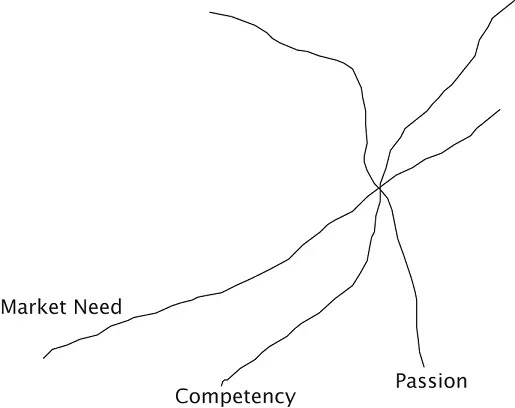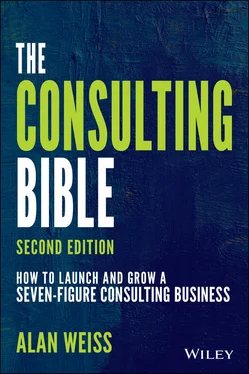Part of emotional support is eschewing the martyr's approach. The humorist George Ade observed once, “Don't pity the martyrs; they love the work.”
Not everyone is in a relationship, of course, which makes it even more important to have an emotional support structure and proper resources. While other consultants can provide this, beware of too much commiseration (“Don't worry about losing that business; we're all losing business right now”). You want people around you who can tell you when it wasn't your fault and when it was . You want people who can help relieve the strain and pressure, but who can also demand accountability and responsiveness.
In short, you need trust. Remember: Trust is the honest‐to‐God belief that the other person has your best interests in mind.
Find those people who can be empathetic (they understand your position) but not sympathetic (they share your feelings and position, and therefore tend to be lost in the content). These resources may change as your business grows and/or as you mature. You will certainly outgrow some of them. This can be a very lonely endeavor if you aren't able to share the pressures, ask intimate questions, and filter unbiased advice. Try to find people who don't have a personal agenda, and include a cross section.
Don't accept all feedback as accurate or valid, but look for consistent patterns and feedback that is supported by evidence and behavior. Most important, never accept unsolicited feedback, which is almost always provided for the sender, not the recipient . If you listen to random suggestions, you'll be the ball in the pinball machine, being tossed and bounced by every arbitrary object in its path.
That just winds up being painful.
The myth about feedback is that it's always valid and worth considering. Listen only to those you respect and whom you ask. That discipline will save you years of grief.
Here's why I've been so focused on your support system.
Your success is at the confluence of the three paths shown in Figure 2.2:
1 Market need, which you identify, create, or anticipate.
2 Competency to deliver quality work and results.
3 Passion to accept rejection and move through obstacles.
If you find market need and have passion but don't have the competency, you'll lose to the competition. If you have competency and passion but can't identify need, you have a story no one wants to hear.
If you have market need and competency but no passion, you have a nine‐to‐five job. And that's an environment most of us have fled from.
Your support system is the engine room for the passion. You need those fires stoked on a continuing basis. Some of us are better than others at providing the passion independently, but at some time or other we all need the support, the structure, the empathy.
At the point where those three lines cross you have the potential for a powerful brand.
Without passion you will be worse than lonely, and poorer than unsuccessful.
You'll be unfulfilled.

FIGURE 2.2Where Do These Paths Intersect?
I'm going to make this simple: There are two available structures for a consulting practice. Both are viable. But to be betwixt and between is bizarre.
The True Solo Practitioner
When you are a true solo practitioner (aka independent consultant) according to the criteria we've discussed thus far (brains not hands, improving the client's condition, and so forth), you work on your own, most often from your home or a shared facility where you rent common space. If it's at all possible, work from home, because it's far more comfortable and much less costly. If the distractions are overwhelming, then find inexpensive shared space. Remember, you go to clients; clients don't come to you. 6 (The pandemic taught all of us the true needs for working at home.)
Every year, you maximize short‐term and long‐term income. In the short term, you pay for all you can out of pretax income. You then maximize your after‐tax income in varying ways (depending on your legal status as a Subchapter S corporation, or LLC). In the long term, you maximize your contributions to both pretax and after‐tax retirement plans: SEP IRA, traditional IRA, Roth IRA, 401(k), and so forth. You do not reinvest in the corporate entity, other than acquiring the normal equipment and technology you need to stay current and effective. You should operate on a cash basis, recording income as it's received and deducting expenses as they are paid (as opposed to an accrual basis).
The distinctions of the true solo consultant include:
No staff, full‐time or part‐time.
Home‐based office.
Outsourced routine needs, such as printing, graphics, web site design, and so on.
Personal responsibility for key tasks, such as invoicing, correspondence, depositing money, processing credit cards, and so on.
Personal credit funds the company until such time as receivables and critical mass of clients create corporate credit.
No purchases of major assets, such as office space.
Branding may be varied, but ultimate brand is one's name (e.g., “Get me Joyce Wilson”).
No plan to sell the business or leave it to family.
Extensions of income include licensing intellectual property and royalties.
Retirement and benefit programs created solely for the benefit of the consultant and family.
Some people who start out as solo consultants choose to move into the creation of a firm later in their careers. That's fine, as long as key transitions are clear. (And some firm principals choose to dissolve their firms and become solo practitioners—more common than you might think, often caused by financial duress or growing intolerance for managing people.)
Many consultants either begin or move into running a firm. That means that every year the principal must reinvest in the firm, with the intent of expanding business, personnel, goodwill, infrastructure, brands, and other accoutrements of what the accountants like to call a “going concern.” That's because the ultimate aim is to sell the business at some point as a multiple of revenues or earnings.
This requires more than merely consulting skills. The firm principal must exercise people management skills, delegation, recruitment, legal discretion, compensation, defections, and so on. Many consultants are refugees from large companies and managing people (including me). To return to this as the owner of the firm doesn't make the obligations any less daunting, frequent, or critical.
In firms, the benefit programs must be inclusive, so that employees derive identical or proportional advantages to the owner. This vastly increases expenses. Salaries and benefits also must be set and adjusted frequently and with care about equity across the board.
Never confuse a solo practice with a boutique firm, or attempt a hybrid. You'll be burdened with the disadvantages of both and few of the benefits of either.
The distinctions of the true boutique firm owner include:
A growing staff, full‐time and part‐time.
Serving as the primary rainmaker, with most people in support.
Separate office space, either rented or owned.
Outsourced specialty needs, but most skills onboard.
Shared responsibility and delegation, especially of clerical functions, scheduling, finances, technology, and so forth.
Discrete banking relationship independent of personal credit based on assets, property, goodwill, and so on.
Читать дальше













